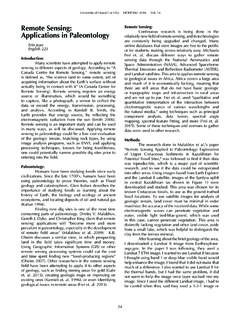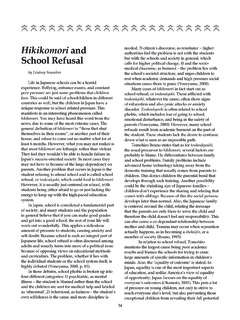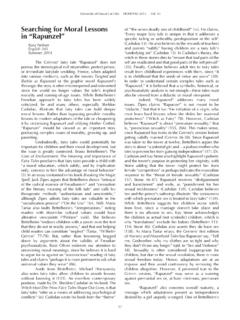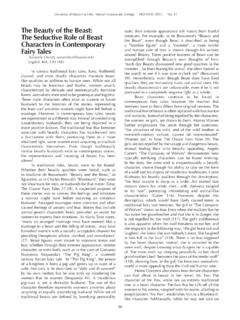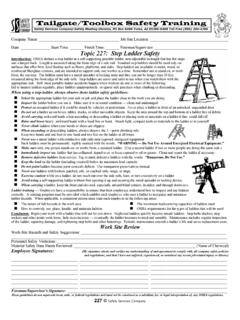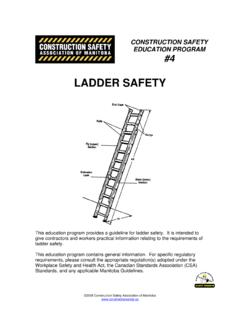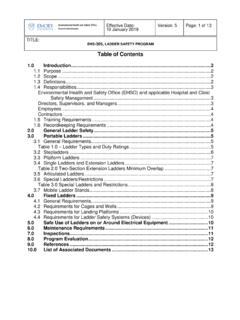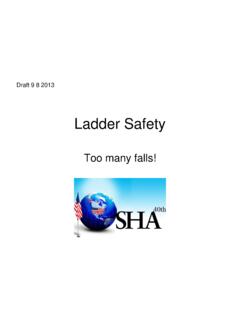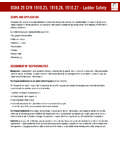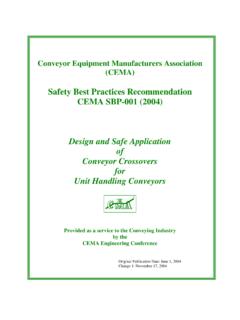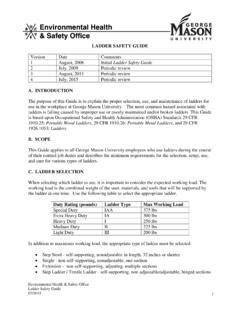Transcription of LADDER SAFETY - University of Hawaii at Hilo
1 LADDER SAFETY (Reviewed 9/27/207) 1. An Introduction to LADDER SAFETY Each year, nearly 300 people are killed and 65,000 seriously injured to careless use of ladders. These tragedies can be avoided. The fact is, a LADDER is one of the simplest, and most east-to-use tools in existence. It takes little more than common sense, combined with the application of the basic rules of LADDER SAFETY , to prevent LADDER -related deaths and injuries. The aim of this training to teach you how to use a LADDER properly and safely. You ll learn how to choose the right LADDER for every job, how to spot a damaged LADDER , how to properly set up a latter, how to climb, and how to work safely while on a LADDER . You ll also learn how to take care of and store your LADDER to ensue that it provides yeas of service. 2. Selecting A LADDER Ladders are manufactured for specific a use, which means, for example, a job that can be safely performed with a step LADDER could become dangerous if an extension LADDER us used instead.
2 You must evaluate the work environment and know what ladders are available before you can choose the right LADDER for the job. Keep in mind all potential hazards. Does electricity pose a possible danger? Will the LADDER be resting on an uneven surface? Is the area crowded with people and materials? Are there obstructions overhead? In addition, you must keep in mind the physical requirements of the job. How much room will there be to position the LADDER ? How much weight combining the user, tools, and materials will be on the LADDER ? How long will the LADDER need to be to safely perform the job? If non-conductivity is not important, then weight should be a major consideration when choosing a LADDER . Aluminum LADDER are the lightest, followed by fiberglass, with wood the heaviest. 3. Types of Ladders Portable ladders are typically manufactured form wood, aluminum,, or fiberglass.
3 The portable- LADDER classification includes straight ladders, extension ladders, trestle ladders, and self supporting stepladders. You probably have most, if not all, of these ladders at your workplace. You may also have ladders specially made for a specific purpose. Familiarize yourself with all of the ladders available to you. This will help you select the proper LADDER for the job. DUTY RATING. A LADDER duty rating tells you its maximum weight capacity. There are four categories of the duty ratings: a) Type IA These ladders have a duty rating of 300 pounds. Type IA ladders are recommended for extra-heavy-duty industrial use. b) Type I These ladders have a duty rating of 250 pounds. Type I ladders are manufactured for heavy-duty use. c) Type II These ladders have a duty rating of 225 pounds.
4 Type II ladders are approved for medium-duty use. d) Type III These ladders have a duty rating of 200 pounds. Type III ladders are rated for light -duty use. Never load a LADDER with a weight in excess of its duty rating. Doing so could damage the LADDER and cause injury. Use a towline to bring up tools and supplies. Do not assume that a longer LADDER has a higher duty rating. There is no relationship between length and duty rating. Before using any LADDER , check its duty rating by looking at the sticker on the side of the LADDER . If the sticker is missing, notify your supervisor. (ANSI requires a duty rating sticker be placed on the side of every LADDER ) DETERMINING THE RIGHT LADDER LENGTH. To help ensure SAFETY when using a LADDER , do not use a LADDER that is too long or too short. If you must stand on or above the first step from the top of a step LADDER , or the third rung from the top of an extension LADDER , it s too short.
5 Your LADDER is too long if ceiling height prohibits proper LADDER set-up. LADDER labels are required by ANSI standards to list the highest standing level. EXTENSION LADDER LENGTH SELECTION GUIDE LADDER Size Maximum Extended Length Working Range to Top Support Maximum Accessible Roof Height Range 16 13 7 to 12 4 to 9 20 17 9 to 16 6 to 13 24 21 11 to 20 8 to 17 28 25 13 to 24 10 to 21 32 29 15 to 28 12 to 25 36 32 17 to 31 14 to 28 40 35 19 to 33 16 to 30 44 39 21 to 37 18 to 34 48 43 23 to 46 20 to 38 According to the extension LADDER length selection guide above, in order to access a roof 25 from the ground, the minimum LADDER length required word be 32 Never over-extend an extension LADDER . See the following chart for ANSI (American National Standards Institute) minimum overlap requirements.
6 LADDER SIZE OVERLAP (FEET) Type I and IA Type II and III Up to and Including 32 3 3 Over 32 Up to and Including 36 4 4 Over 36 Up to and Including 48 5 5 Over 48 6 ---- Remember, you must never stand on or above the third rung form the top of an extension LADDER , or the second step from the top of a stepladder THE WORK ENVIRONMENT. Your choice of ladders is also influenced by the environment of your work site. For example, you d want to use a clean, dry all wood or fiberglass LADDER if you were working near sources of electricity. That s because metal ladders can easily conduct electricity to you, causing serious injury or death. Don t forget that sweat, oil, paint, caulk, and grease can conduct electricity. Make certain your LADDER is free of these substances. 4. Inspecting A LADDER Always check for damage before using any LADDER .
7 Conduct your inspection before you leave for the job site. A. Begin at the bottom, making sure the feet are not broken or malfunctioning and that the slip-resistant pads are secure. B. Inspect the LADDER for cracks, bends, and splits on side rails, rungs, and steps. C. Check all rung/step-to-side rail connections, as well as hardware, fittings, and accessories. Make sure both rung locks are in working order. D. Test the rope and pulley. Look for fraying of the rope and smooth operation. E. All pivotal connections and the rung-lock should be well-lubricated. F. All bolts and rivets should be secure. Never use a LADDER if any bolts or rivets are missing of if the joints between the steps (or rungs) and the side rails are not tight. G. Make sure the LADDER (particularly the steps and rungs) is free of foreign materials such as oil and grease.
8 H. If you re using a stepladder, make sure the spreader braces are secure and working. Use a LADDER -inspection chart as a guide for evaluating the SAFETY of the LADDER . Remember to inspect the LADDER before you travel to the job site, as once you re there you ll be tempted to use the LADDER regardless of its condition. Always mark unsafe LADDER by using a damaged- LADDER tag. Be sure to store damaged ladders away from usable ladders. Have them repaired as soon as possible. Destroy un-repairable ladders immediately. 5. Transporting A LADDER Many accidents happen while transporting the LADDER to the job site. A LADDER is long and awkward, and can cause injuries and property damage during transport. When possible, two people should carry an extension LADDER . If you carry it yourself, keep the front end of the LADDER slightly higher than the back end.
9 Never move or reposition an extension LADDER without completely retracting the fly section. Failure to do so can cause serious injury or death. Secure both ends of a LADDER when transporting it on a vehicle. 6. Setting Up a LADDER A major cause of falls from ladders is improper set-up. Many accidents can be avoided with common sense and good work practices. Using proper set-up techniques will give your LADDER maximum stability and help ensure your SAFETY . PREPARING TO USE A LADDER . Your first step is to rid the area of hazards. A. Look above for any overhead wires or obstructions. B. Clear any clutter from the area around the base of the LADDER . C. Block off the area around the LADDER so people and equipment won t knock you off the LADDER . D. If you re working close to a corner, put up a sign to warn people of your presence.
10 E. If there s a door nearby, lock it, block it off, or station someone to watch it for you. ANGLE OF INCLINATION. Extension and straight ladders should be erected at a pitch of 75 degree for the horizontal for optimum resistance to sliding, strength of the LADDER , and balance of the climber. To create the 75 degree angle, the LADDER should be one foot away from the wall for every 4 feet of the LADDER s length to the support point. This is known as the one-quarter rule. When setting up an extension LADDER , first position it flat on the ground with the bottom of the LADDER touching the base of the building and the base section on top. Lift the LADDER by walking it up with your hands, one rung at a time. Pull the base of the LADDER slightly away from the building. Lift the fly section and lock it.

